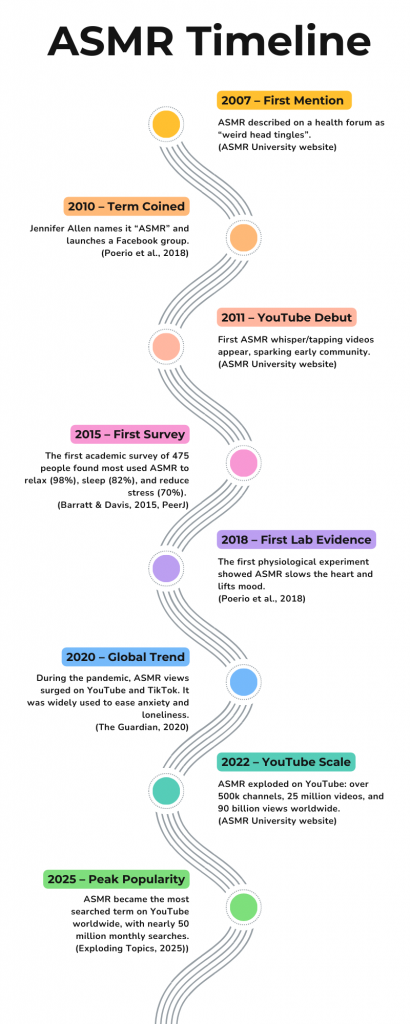One in three people in the UK struggles with insomnia, and many now turn to whispering or tapping videos for relief. How is this YouTube trend helping them sleep?
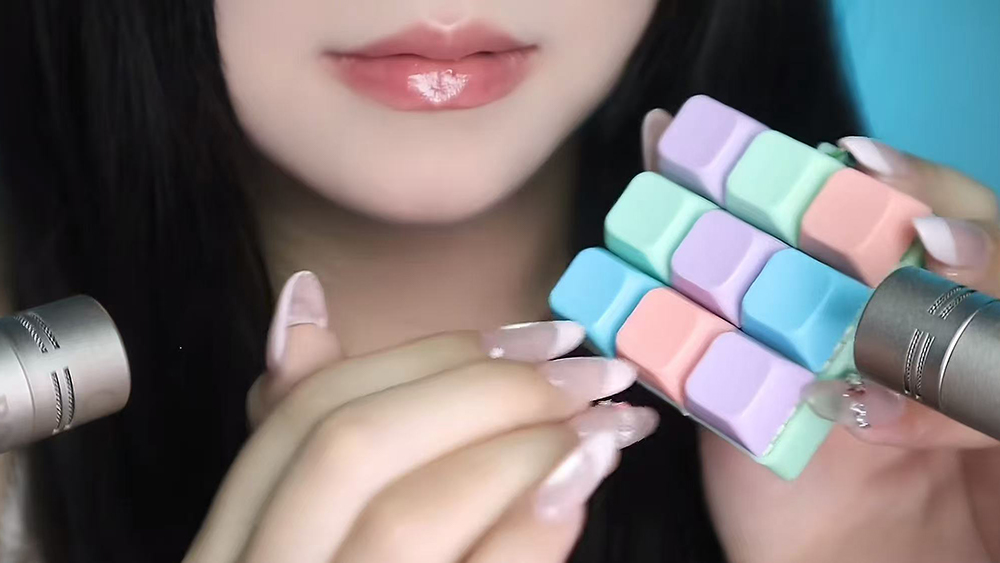
At three o’clock in the morning, 19-year-old Simin Zhao was still awake. She closed her eyes and tried hard to calm down, but the more she tried to force herself to fall asleep, the more confused her mind became. Checking her clock for the 100th time, she found that only 40 minutes had passed in what felt like hours.
There was only one option left… putting her headphones in, she scrolled to an online video of someone rubbing a microphone. By delicately rubbing with a brush, the creator created a sound not unlike the wind or the kind of white noise that might come from a television set after broadcasting has stopped. Her breathing became steady and drowsiness slowly crept over her.
Videos like this that bring relaxation through friction, tapping and whispering are growing in popularity online. More young people are using them as a way to help them fall asleep and thousands of creators are producing videos to meet the demand.
“I used to suffer from insomnia at night, tossing and turning for a long time and unable to fall asleep. Since I started watching these videos, I can fall asleep quickly with headphones on,” said Simin.
These videos are known as Autonomous Sensory Meridian Response videos (ASMR). You might recognise the feeling that they generate: a tingling sensation on the scalp and a relaxed mind as a response to certain specific sounds.
In this type of video, the scene is usually extremely quiet. The host does not speak loudly but repeatedly performs some gentle operations, such as the sound of rubbing fingers and tapping nails on different objects. All the sounds are amplified by the microphone, allowing the listener to hear every tiny friction and vibration.
There is some scientific evidence behind ASMR. It has been found to activate areas of the brain associated with relaxation, helping people enter a state that makes it easier to fall asleep. According to Dr Craig Richard, the founder of ASMR University website: “ASMR activates specific areas in the brain and induces brain waves related to relaxation.”
This type of relaxation of brain waves is particularly important for young people who are overloaded with information. One of the reasons why young people have difficulty falling asleep is that they are accustomed to using mobile phones for a long time before going to bed. A study in 2024 found that people who frequently browse social media are more likely to be irritable before going to bed, which makes it harder for them to fall asleep.
Simin knows this problem all too well. “Sometimes I watched horror videos before going to bed and I couldn’t calm down for a long time. But as long as I turn on the ASMR, I calm down and fall asleep very easily,” said Simin.
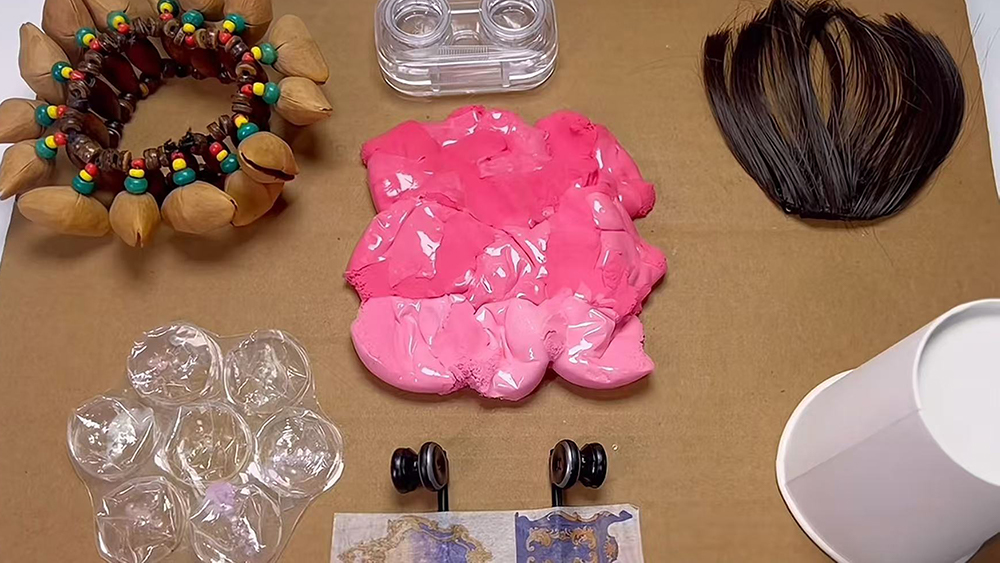
People with anxiety also use ASMR before going to bed to quiet their brains, thus falling asleep more easily. According to Dr. Richard, “An increasing number of clinical studies have shown that the relaxing effect of ASMR is even sufficient to help patients diagnosed with anxiety or insomnia.”
ASMR became a new form of relief for some young people who have just entered the workplace. Yutong Han, 25, works at an Internet company in Beijing. She under intense work pressure and is constantly bombarded with information.
“I used to fall asleep easily without any of these, but since I started working, I’ve been under a lot of pressure and often have a jumbled mind, making it hard for me to fall asleep,” said Yutong. Nowadays, watching ASMR live stream before going to bed every night has become her way to relieve stress.
“The first time I listened to this type of video, I fell in love with it. At that time, I felt a tingling sensation on my scalp and was extremely sleepy,” said Yutong. Now her favourite is the sound of tapping the wooden blocks to the rhythm of the music. “It sounds particularly rhythmic and very comfortable, making me relax immediately.”
Different people are attracted by different sound effects. These are called their trigger sounds, meaning those specific sounds that can make them relax and feel a stinging sensation. The sound that Yutong likes is just one of many trigger sounds. In the comment section of ASMR videos, viewers often leave messages sharing their favourite sounds, such as the sound of cleaning ears, combing hair, turning pages, blowing air…
For some people, ASMR has become a daily bedtime ritual. 24-year-old Tingting Hu watches ASMR videos every day before going to bed. “Even if I’m extremely sleepy and don’t need it to help me fall asleep, I will still click on it. Otherwise, I always feel like something is missing,” said Tingting.
Unlike those who only enjoy simple sound stimulation, Tingting prefers role-playing videos. For instance, the creator acts as a personal makeup artist and asks you in a soft voice, “What kind of makeup do you want today?” In front of the camera, she gently pats the powder puff and then makes a rubbing sound with a makeup brush.
“These videos give me a feeling of being accompanied and cared for,” Tingting said. She realised that she might have relied too much on this content, but she didn’t want to change it. “I need something to lean on. At least I know how to deal with stress and sadness when they come.”
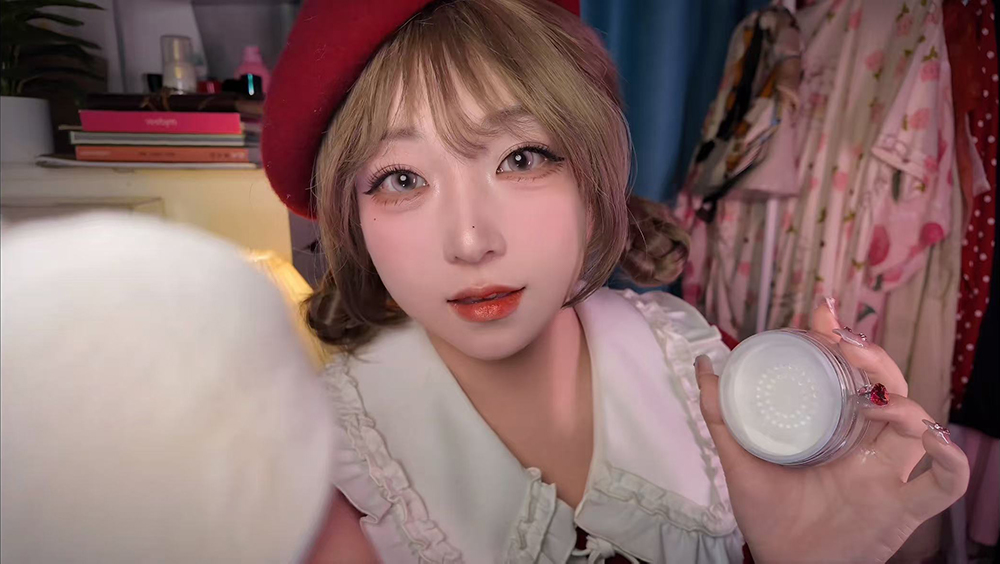
This feeling of being accompanied is precisely the key to the appeal of role-playing ASMR. Dr. Craig Richard said in a 2018 interview that the reason why such videos are effective is that they evoke a sense of being cared for, like the feeling of being combed by your mother when you were a child. Although ASMR videos cannot truly touch the body, through the simulation of sound, they activate similar feelings of security and being cared for in the brain.
Compared with ASMR focused on trigger sounds, role-playing places more emphasis on the face-to-face feeling and creating an atmosphere of being cared for. The content of the videos is often set in daily life, such as helping you with makeup, checking your body, combing your hair, or having a gentle conversation. These videos satisfy the audience’s inner longing for tenderness and companionship.
Rui Lin, 19, has never been in a relationship. She enjoys watching lover role-playing videos. One of her favourites is that the creator acts as a lover to treat your wounds. The creator looked at the camera and asked softly, “Are you okay? I’m really worried about you.” Then she picked up the cotton ball, disinfected it for you.
“Every time I watch this kind of video, it gives me a feeling of being cared for and accompanied,” said Rui.
She also knows that this gentleness is just a designed script. “I won’t take it seriously because these people are too ideal for reality,” said Rui. But every time she watched it, she couldn’t help but look forward to it: “In real life, is there really someone as gentle, inclusive and unconditionally loving me as in the video?”
Many viewers project their expectations onto the characters in the video. Chinese ASMR creator Dingdang has gained attention with his series titled “Male deskmate who has a crush on you”. “Some people’s real-life partners are not that considerate, so when they watch videos, they might think this is the kind of relationship they want,” said Dingdang.
The feedback triggered by romantic role-playing videos is often different from that of other types of ASMR. “People pay more attention to your eyes, your acting skills, and the atmosphere you create, rather than just the auditory experience itself,” said Dingdang.
In fact, many ASMR videos of lovers role-playing usually create a sense of intimacy through gentle dialogues and scenes close to daily life. An ASMR website offers tips on how to make a boyfriend role-playing video. For instance, design a script that can evoke emotional resonance. Another approach is to recreate daily scenes, such as having breakfast together or telling bedtime stories. All of these can enhance the audience’s sense of immersion.
The popularity of this kind of content actually reflects the emotional loneliness problem among young people. According to the UK government’s Community Life Survey, loneliness was higher for 16–24-year-olds than for any other age group.Despite being active on social media on a daily basis, they lack a real emotional connection.
To a certain extent, ASMR can alleviate the problem of young people lacking emotional connections. Professor Shuo Niu from Clark University said in a 2021 interview that the soft voice and approachable presentation style in ASMR videos make people feel as if someone is by their side. Even if this kind of company is virtual, it can still bring real comfort when one feels lonely or tired.
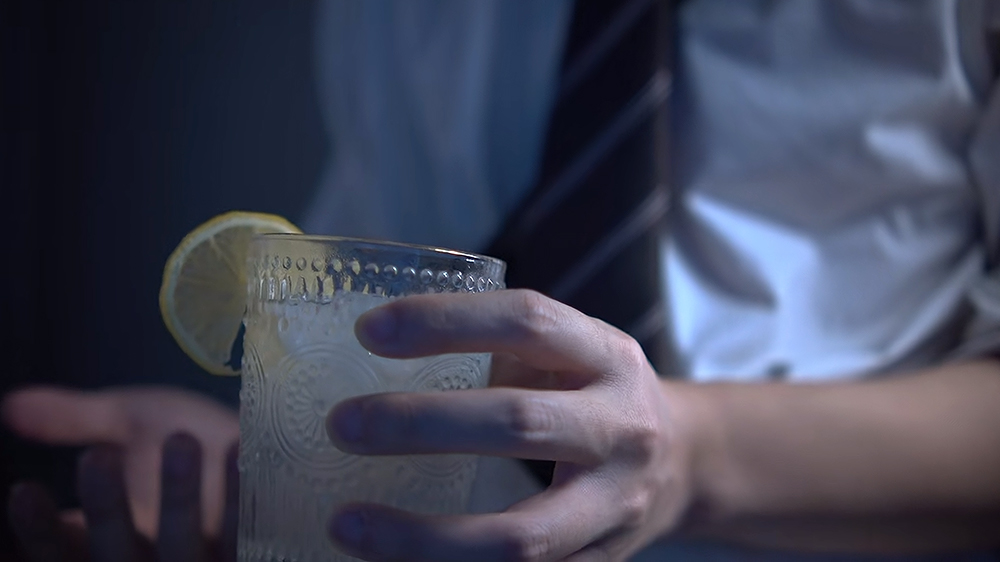
However, not all the audience are seeking emotional satisfaction. Yutong is more about feeling that there is someone by her side. Every night, she watches the ASMR live stream for half an hour, watching the host whisper softly and move gently in front of the camera, as if someone is accompanying her to sleep.
“When I sleep alone, I tend to have all kinds of wild thoughts. ASMR live streaming gives me a sense of companionship. I know there is a person who is awake now, doing these things to lull me to sleep, so I don’t feel scared,” said Yutong.
Compared with pre-recorded videos, live streaming brings more of a sense of presence. ASMR streamers usually don’t talk much. They will create sounds that the audience likes in front of the camera based on the interaction in the bullet comments.
Yutong regards the creator as “someone who lulled me to sleep”. “There was a sense of the intimacy, but not the kind of emotional intimacy,” said Yutong. She never joins the fan groups of the live-streamers and never interacts in the bullet comments. “I think the simpler it is, the better. If there’s too much interaction, it will lose its original flavor.”
ASMR provides emotional comfort not only for ordinary viewers, but sometimes it can also unexpectedly help some people who particularly need relaxation.
Yufei Chen, an ASMR creator from China, once received a private message that left a deep impression on her. A parent of an autistic child told her that the child was particularly sensitive to the sound of clothes rubbing against each other in her videos. Every time they heard this sound, they could gradually calm down from their restlessness and sleep more soundly.
Wales ASMR creator Laura said that she often receives messages from PTSD patients. Many people say that after experiencing a tense or fearful episode, listening to her videos can gradually calm them down and relieve their uncomfortable emotions.
The sensory experience brought by ASMR is not effective for everyone. Dr. Craig Richard mentioned in a 2024 podcast that about 10% to 30% of people would have a mild or strong reaction to ASMR videos. A study in 2025 also found that people’s brain responses vary greatly when watching ASMR, which indicates that it is not a relaxation method suitable for everyone.
Some creators believe that not feeling any sensation does not mean ASMR is ineffective. Chinese ASMR creator Yufei said, “Perhaps they just haven’t found their own trigger sound yet.” However, it’s just the creator’s speculation and has not yet been confirmed by research.
There are some other methods to help people fall asleep or relieve their emotions, such as mukbang videos, where bloggers eat on camera and make chewing sounds, white noise, meditation music or bedtime story audio. Although in different forms, these methods all serve a similar purpose.
The popularity of ASMR is also driven by the promotion of Internet platforms. Data shows that the number of views for videos with the ASMR tag on TikTok has reached over 370 billion times. In addition, creators such as Gibi ASMRhave over five million subscribers and billions of views, demonstrating the commercial influence of ASMR.
Now, it is gradually moving out of mobile phone screens and into real life. In New York, the first ASMR spa, WhisperWave, opened in January 2024. In the dim candlelight and soft background music, customers can truly experience services such as soft whispers, feather brushes, and combing hair. The entire service lasts for 90 minutes and costs as much as 150 US dollars.
The New York Post once reported on a customer’s experience at WhisperWave. She described the feeling, “swirling a singing bowl over my head, its vibrations humming through my body. And the founder “playfully mimicked cracking an egg on my scalp, letting her fingertips trickle down my neck like yolk.” These feelings made her relax, as if she were back in her childhood when she was coaxed to sleep by her mother.
However, not all ASMR audiences recognise the value of this offline experience. Yutong said, “If I am going to spend money, why not really get a professional ear cleaning or a massage?”
Whether it’s the soft whispers on mobile phones or the tactile experiences offline, ASMR has become a cultural phenomenon that cannot be ignored. It remains to be seen whether it is a short-lived trend or will change the way people relieve stress and loneliness in the long term.
